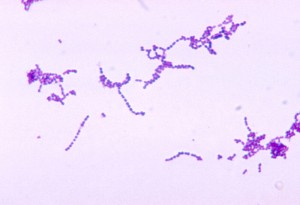Group B Strep (GBS) is a source of significant morbidity and sometimes mortality.
Many women are asymptomatic carriers.
Although GBS infections among the newborn are uncommon, it is possible to reduce the frequency of neonatal GBS. A variety of schemes to reduce perinatal GBS infections have been proposed.
One method is to treat on the basis of risk. A second method is to treat on the basis of screening cultures.
Using the risk factor approach, women with any of the following risk factors are treated for possible GBS:
- Previous infant with invasive GBS disease
- Documented GBS bacteruria during this pregnancy
- Delivery at
- Ruptured membranes 18 hours or longer (some say 12 hours or longer)
- Fever during labor of 100.4 or greater

Treatment consists of:
- Penicillin G, 5 million units IV, followed by 2.5 million units IV every 4 hours until delivery, or
- Ampicillin 2 gm IV, followed by 1 gm IV every 4 hours until delivery, or
- Clindamycin 900 mg IV every 8 hours, or
- Erythromycin 500 mg IV every 6 hours until delivery, or
- Other broad-spectrum antibiotics if clinically indicated
Using the culture screening technique may be a little more effective. Using this method, all pregnant women at about 36 weeks gestation are screened with a vaginal/rectal culture for strep. Those who are positive are treated as above… those who are negative are not treated.
Some physicians use both methods, screening everyone at 36 weeks, but also treating high-risk patients.
